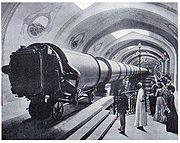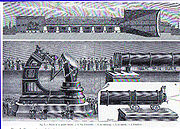
Great Paris Exhibition Telescope of 1900
Encyclopedia

Objective (optics)
In an optical instrument, the objective is the optical element that gathers light from the object being observed and focuses the light rays to produce a real image. Objectives can be single lenses or mirrors, or combinations of several optical elements. They are used in microscopes, telescopes,...
of 1.25 m (49.2 inches) in diameter, was the largest refracting telescope
Refracting telescope
A refracting or refractor telescope is a type of optical telescope that uses a lens as its objective to form an image . The refracting telescope design was originally used in spy glasses and astronomical telescopes but is also used for long focus camera lenses...
ever constructed. It was built as the centerpiece of the Paris Universal Exhibition of 1900
Exposition Universelle (1900)
The Exposition Universelle of 1900 was a world's fair held in Paris, France, from April 15 to November 12, 1900, to celebrate the achievements of the past century and to accelerate development into the next...
. Its construction was instigated in 1892 by François Deloncle (1856–1922), a member of the French Chambre des Députés
Chamber of Deputies of France
Chamber of Deputies was the name given to several parliamentary bodies in France in the nineteenth and twentieth centuries:* 1814–1848 during the Bourbon Restoration and the July Monarchy, the Chamber of Deputies was the Lower chamber of the French Parliament, elected by census suffrage.*...
. Since it was built for exhibit purposes within a large metropolis, and its design made it difficult to aim at astronomical objects, it was not suited for scientific use. When the year-long exposition was over, its builders were unable to sell it. It was ultimately broken up for scrap; the lenses are still stored away at the Paris Observatory
Paris Observatory
The Paris Observatory is the foremost astronomical observatory of France, and one of the largest astronomical centres in the world...
.
Design

Focal length
The focal length of an optical system is a measure of how strongly the system converges or diverges light. For an optical system in air, it is the distance over which initially collimated rays are brought to a focus...
of 57 m (187 ft). Due to its extremely large size, the telescope was mounted in a fixed horizontal position. Light from astronomical objects was redirected into the optical tube assembly via a Foucault
Léon Foucault
Jean Bernard Léon Foucault was a French physicist best known for the invention of the Foucault pendulum, a device demonstrating the effect of the Earth's rotation...
siderostat
Heliostat
A heliostat is a device that includes a mirror, usually a plane mirror, which turns so as to keep reflecting sunlight toward a predetermined target, compensating for the sun's apparent motions in the sky. The target may be a physical object, distant from the heliostat, or a direction in space...
, a movable plane mirror 2 m (6.56 ft) in diameter, mounted in a large cast-iron frame at the objective lens end of the telescope. The horizontal steel tube was 60 m (197 ft) long. The telescope’s eyepiece/plate end could be shifted five feet on rails for focusing. With the lowest power of 500×, the field of view was 3 arc minutes.
Construction of the telescope

Erection of the telescope

Champ de Mars
The Champ de Mars is a large public greenspace in Paris, France, located in the seventh arrondissement, between the Eiffel Tower to the northwest and the École Militaire to the southeast. The park is named after the Campus Martius in Rome, a tribute to the Roman god of war...
, near the Eiffel Tower
Eiffel Tower
The Eiffel Tower is a puddle iron lattice tower located on the Champ de Mars in Paris. Built in 1889, it has become both a global icon of France and one of the most recognizable structures in the world...
. The tube, oriented north-south, was made up of 24 cylinders 1.5 meters in diameter and rested on 7 concrete and steel pillars; its axis was 7 meters above the floor. The room at the end which housed siderostat
Heliostat
A heliostat is a device that includes a mirror, usually a plane mirror, which turns so as to keep reflecting sunlight toward a predetermined target, compensating for the sun's apparent motions in the sky. The target may be a physical object, distant from the heliostat, or a direction in space...
with the mirror had a movable dome to allow direct access to the sky.
Aftermath
mage:Great Ex Telescope Cartoon.jpg|right|thumb|An 1892 cartoon ridiculing François Deloncle who proposed the pr auction in 1909. No buyer was found and eventually the components were scrapped. The 2-meter diameter mirror is on display at the Observatoire de ParisParis Observatory
The Paris Observatory is the foremost astronomical observatory of France, and one of the largest astronomical centres in the world...
, and two of the lenses have recently been discovered in packing crates in the basement.
Throughout its existence the telescope was the butt of many derisive jokes and unflattering cartoons. In part this was due to the belief of the academic community that the telescope would be completely useless. But as the centrepiece of an exhibition showcasing the best of the recent advances in industry and technology it served its purpose.

